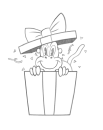Want more? Join the premium course and get full access to all lesson, demos, assignments, and critiques!
In this lesson, I'm going to share quick ways to indicate feet and their positioning when you're trying to get that solid ground plane for your figure. The way I like to think about feet is really just versions of a triangle.
Basic Shapes for Feet
I start with some average views or positions to get the different perspectives of the foot.
The Triangle Approach
Front View: I take the basic triangle, with open lines at the top representing the width of the lower leg. I flare those lines out to show the broadening of the foot. A line indicates the front, and I make a little notch for where the big toe might be.
Three-Quarter View: Similar to drawing hands, I create a big envelope with no more than four to five lines. This includes the back, side, and front lines, plus one relational line from the front of the shin down into the top of the toe. I keep this line smooth to represent the flow of the tendons from the extensors into the foot.
Profile View: I lose the straight front line and extend the length of the foot outward.
Back View: Using the heel as my substitute front plane, I draw three lines, the back (heel), the side, and a C-curve from the front down. I include the width of the heel to create a nice perspective triangle that tracks the ground plane, suggesting the foot's triangular stability.
Gesture Variations
Adjusting the Basic Shape
I can take any of my standard views and adjust the lines to create different gestures.
Taking a Step: If someone's taking a step, I might use an S-curve instead of straight lines. This shows the bottom of the foot stretching or getting taller, and the front starting to pinch more.
Pinching and Stretching: I can pinch and stretch the glove or sock shape of the foot to give it a different gesture quality. For example, the toes might pinch against the floor.
Toe Positions
- Big Toe: The big toe is the only one that faces up toward the sky.
- Remaining Toes: The other toes grip the floor, all going down in the same direction.
Including Anatomical Details
The Ankles
I like to include the ankle bones, especially if I see the relationship between both. There's a nice asymmetry between them. I think of the ankle as grabbing onto the top of the tarsus group, like a wrench that grabs onto that group.
The Arches of the Foot
The foot exists on two arches:
- Longitudinal Arch: From the heel (calcaneus) up to the tarsus, down to the metatarsus, and then to the toes. It's like an arch or a bridge.
- Transverse Arch: From side to side, like the peak of the bones in your palm, with a high to low from side to side.
These arches make the foot feel more elegant and natural.
Proportions of the Foot
Understanding the proportions helps in drawing the foot accurately.
Comparison with the Hand
- Hand:
- Carpal Tunnel: One-third
- Metacarpals: Two-thirds
- Fingers: The whole second half
- Foot:
- Tarsus Group: Half
- Metatarsus: Two-thirds
- Toes: One-third
The foot's proportions are the reverse of the hand, emphasizing the foot's role in weight and balance.
Drawing the Underside of the Foot
When drawing the underside, think of a footprint.
- Footprint Shape: Footprints are asymmetrical because of the long padding across the outside and the arch on the instep. The heel and the ball of the foot make contact, with the arch raised.
Gesture for the Underside
I use curved lines to represent the padding and the arch. By turning this into a little plane that curves, I can capture the static or standard view from beneath.
Examples and Tips
Back Three-Quarter View
- I look for the S-curve of the calf and Achilles tendon down to the back of the foot.
- I draw the heel block (calcaneus bone) and the flow line down to the top of the toe.
- Including the ankle bones adds asymmetry and natural feel.
Front View with Weight Distribution
- I emphasize areas where weight is placed by using hard angles.
- The padding being squashed by the weight can be shown through pinches and stretches.
Pinching and Stretching
- I adjust the sock shape to have different gesture qualities.
- Pinching and stretching parts of the foot conveys movement and weight distribution.
* * *
I always begin drawing the feet this way, especially the basic average types, the front, three-quarter, and side views. In gesture drawing of the whole figure, I end the feet with these simple four to five lines to ensure that the figure is grounded, and the feet explain the perspective of the ground plane.
The purpose of drawing feet this way is to focus on the most important thing: building continuity with your figure and putting it on the ground. By forcing yourself into a four to five line description, you avoid getting bogged down with unnecessary details like bumps and veins.
Once you have that setup, the foot can become whatever you want it to be. I don't depart too much from these gestural lines, I might build some information in, but I maintain the nice curve of the top of the foot, the look of the tendon ramp and the extensors.
Gesture is always that beginning, the simplified way of stating position and quality to a pose. There are moments that break through and feel like they're the final as well. This method helps create feet that are elegant, natural, and grounded.
Want more? Join the premium course and get full access to all lesson, demos, assignments, and critiques!




